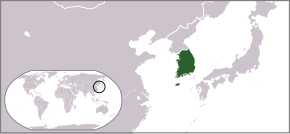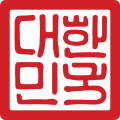
Back Cuarta República de Corea del Sur AST Четвърта република Южна Корея Bulgarian Cuarta República de Corea del Sur Spanish جمهوری چهارم کره Persian Quatrième République (Corée du Sud) French Republik Korea Keempat ID 第四共和国 (大韓民国) Japanese 대한민국 제4공화국 Korean Republik Keempat Korea Selatan Malay Quarta República da Coreia do Sul Portuguese
This article needs additional citations for verification. (December 2009) |
Republic of Korea 대한민국 大韓民國 | |||||||||
|---|---|---|---|---|---|---|---|---|---|
| 1972–1981 | |||||||||
| Anthem: 애국가 "Aegukga" | |||||||||
| National seal "국새" | |||||||||
 | |||||||||
| Capital | Seoul | ||||||||
| Common languages | Korean | ||||||||
| Government | Unitary semi-presidential republic under an authoritarian[a] dictatorship[3][4][5] | ||||||||
| De facto leader of South Korea | |||||||||
• 1979–1980 | Chun Doo-hwan | ||||||||
| President | |||||||||
• 1972–1979 | Park Chung Hee | ||||||||
• 1979–1980 | Choi Kyu-hah | ||||||||
• 1980 | Park Choong-hoon (acting) | ||||||||
• 1980–1981 | Chun Doo-hwan | ||||||||
| Prime Minister | |||||||||
• 1972–1975 | Kim Jong-pil | ||||||||
• 1975–1979 | Choi Kyu-hah | ||||||||
• 1979–1980 | Shin Hyun-hwak | ||||||||
• 1980 | Park Choong-hoon (acting) | ||||||||
• 1980–1981 | Nam Duck-woo | ||||||||
| Legislature | National Assembly | ||||||||
| Historical era | Cold War | ||||||||
• Established | 21 November 1972 | ||||||||
| 26 October 1979 | |||||||||
| 12 December 1979 | |||||||||
| 17 May 1980 | |||||||||
| 18 May 1980–27 May 1980 | |||||||||
• Disestablished | 24 February 1981 | ||||||||
| Currency | South Korean won | ||||||||
| |||||||||
| Today part of | South Korea | ||||||||
| History of South Korea |
|---|
 |
|
|
The Fourth Republic of Korea (Korean: 제4공화국; RR: Je sa Gonghwaguk; lit. "Fourth Republic") was the government of South Korea from November 1972 to February 1981.
The Fourth Republic was founded on the approval of the Yushin Constitution in the 1972 constitutional referendum, codifying the de facto dictatorial powers held by President Park Chung Hee, and succeeding the Third Republic. Park and his Democratic Republican Party ruled under the centralized and authoritarian Yushin System until the assassination of Park on 26 October 1979. The Fourth Republic entered a period of political instability under Park's successor, Choi Kyu-hah, and the escalating martial law declared after Park's death. Choi was unofficially overthrown by Chun Doo-hwan in the coup d'état of December Twelfth in December 1979, and began the armed suppression of the Gwangju Uprising against martial law. Chun launched the coup d'état of May Seventeenth in May 1980, establishing a military dictatorship under the National Council for Reunification and dissolving the National Assembly, and was elected president by the council in the August 1980 presidential election. The Fourth Republic was dissolved on the adoption of a new constitution in March 1981 and replaced with the Fifth Republic of Korea.
- ^ Noh, K. J. (2021-12-02). "South Korean Dictator Dies, Western Media Resurrects a Myth". Hampton Think. Retrieved 2025-05-13.
- ^ Kwak, Tae Yang (2018-10-30). "CULTURES OF YUSIN: South Korea in the 1970s | Edited by Youngju Ryu". pacificaffairs.ubc.ca. Pacific Affairs. Retrieved 2025-05-13.
- ^ Cho, Joan E. (2024-02-13). Seeds of Mobilization: The Authoritarian Roots of South Korea's Democracy. University of Michigan Press. pp. 2, 4, 178. ISBN 978-0-472-90403-7. Retrieved 2025-05-16.
- ^ The perfect dictatorship? Comparing Authoritarian Rule in South Korea and in Argentina, Brazil, Chile and Mexico. Jorge I. Dominguez, Harvard University
- ^ May, R.J. (2004). The Military and Democracy in Asia and the Pacific – Changes in Military Rule: The Park Chung Hee and Chun Doo Hwan Regimes. ANU Press. pp. Chap. 8, Sec. 2. Retrieved 2025-05-16.
Cite error: There are <ref group=lower-alpha> tags or {{efn}} templates on this page, but the references will not show without a {{reflist|group=lower-alpha}} template or {{notelist}} template (see the help page).


